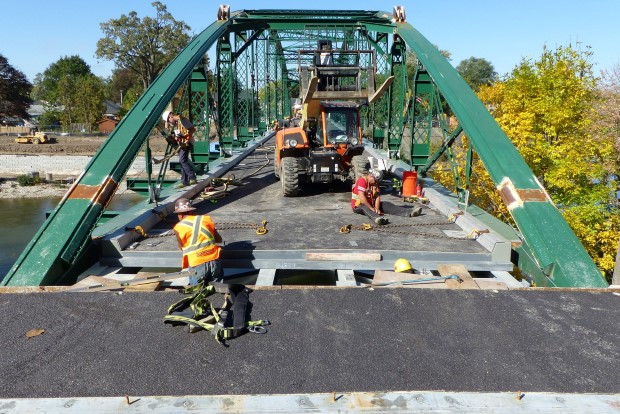I thought for a moment. I recalled how my old Morgan was built in the days before seat belts. When I sold the roadster, the first thing the new owner did was install seat belts. This was an act of rehabilitation and something I should have done years ago. I had allowed myself to be seduced by the restoration mythology: if it wasn't there originally, it shouldn't be there. Period. And bunkum. Old or new, equipment must meet today's safety requirements. Anything else is stupid. I had been stupid.
I wonder about all the unpainted stuff that I found all over the Blackfriars Bridge. The corrosion would not have been acceptable on an old car, rehabilitated, restored, re-anythinged. Still, it is an old bridge and not an old car.
Those running the City of London should be proud. The continuing presence of the Blackfriars Bridge over the North Branch of the Thames River is remarkable. The fact it is also still carrying traffic is a rare achievement.
If you had assumed a 143-year-old structure would not have been designed to meet today's demands, you'd have been right. (Heck, my Morgan was only 45 year old and it fell short.)
It is for some very good reasons that the Blackfriars Bridge of today is not, for the most part, the original structure. Instead, it is a ghost, an elegant reminder that the past is past, that times change and that stuff must change too or be left behind. The Blackfriars Bridge has changed. It has not been left behind.
This is not a restored structure but a rehabilitated one, and a somewhat repurposed one. It no longer carries horses pulling farm wagons but cars, albeit in only one direction, plus numerous pedestrians and cyclists.
 |
| Top detail of derelict Wrought Iron Bridge Co. bridge arch. |
Since that first "significant work", the bridge has undergone a lot of significant remedial work. I'd argue the bridge standing over the river today is a new bridge which incorporates the visual elements of the original bowstring-arch truss bridge.
I'm old enough to recall when hundreds, if not thousands, of wrought-iron bridges were still in use throughout both Canada and the United States. Almost all are now gone. Worn out, demolished, replaced.
 |
| Restoration: really? |
The myth of restoration is a killer. Structures have been demolished when found impossible to restore. Restoration can be an impossibly high bar to clear. Why? Because of what true restoration entails.
Restoration modifies an heritage structure to accurately reflect its appearance at a specific point in its past. This may involve the addition or the removal of structural material.
The engineers who rebuilt the London bridge to meet today's demands proclaimed quite openly that they were rehabilitating the structure. Rehabilitating is not restoring.
There is very little of the original bridge in this latest incarnation. This is as it should be if the goal is to keep the bridge in use. Once we get our heads around the truth that restoration is not the only way to honour the past, opportunities appear all around us. Think of Old Quebec. As I wrote in a previous post:
I am old enough to recall when many of the present "heritage" structures (in old Quebec) were not there. Many of these buildings were not restored but recreated. Much of the area's 18th century ambiance so loved by tourists is faux.
Once we accept that our new bridge is a glorious salute to the past, a glowing, functioning memory, we find it possible to openly ask, what is the best approach to preserving the illusion of heritage? To answer this, we must bring artists and historians into the rebuilding effort and not just engineers. Artists like Ted Goodden, who featured the bridge in his art, can bring a lot to the rehabilitation table.
Those who take the time to look will discover that the new Blackfriars Bridge is magic--a practical answer wrapped in romance and sentimentality. Gérard Morisset, the art historian behind the reclaiming of Old Quebec's heritage texture, argued it is completely acceptable to restore a structure "to a state of completeness that may never have existed."
 |
| A construction update picture posted by The City of London. |






